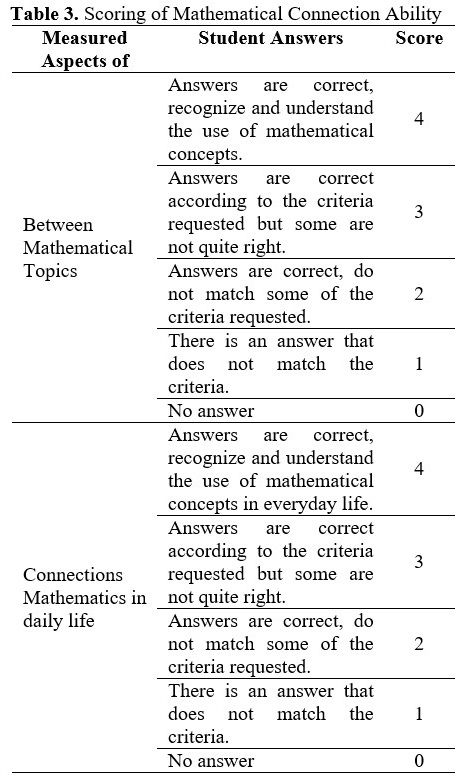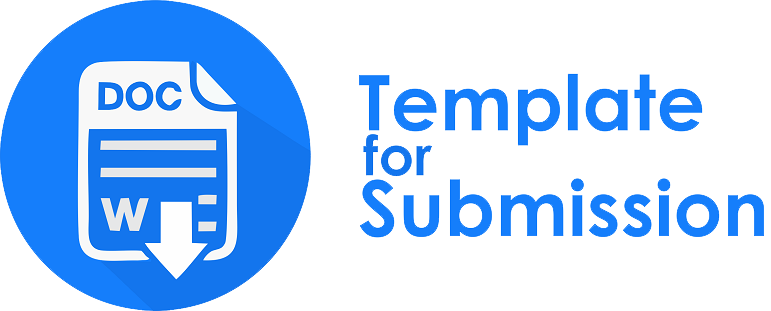MATHEMATICS CONNECTION ABILITY FOR JUNIOR HIGH SCHOOL STUDENTS BASED ON LEARNING INDEPENDENCE LEVEL
Abstract
Mathematical connection ability is one of the basic mathematics skills that must be possessed by junior high school students. It turns out that so far, the student's learning outcomes in terms of mathematics have not been encouraging. This study aims to describe the mathematical connection skills of junior high school students in solving a problem in terms of learning independence. This research is a qualitative descriptive study on eighth-grade students in a junior high school in Lamongan district, East Java. Data was collectied using test questions, interviews, and questionnaires. This study obtained the following results: 1) one subject (S2) who has high mathematical connection ability with low learning independence, 2) one subject (S1) who has moderate mathematical connection ability with moderately high learning independence, and 3) two subjects (S3 & S4) who have low mathematical connection skills with low learning independence. The internal causes of the lack of mathematical connection skills and student learning independence are the lack of practice questions, the lack of motivational stimulus to encourage students to study independently. While external factors are the level of test questions that are tested too difficult and the lack of supporting learning information sources
Downloads
References
Agustiani, S. (2020). Analisis Kemampuan Koneksi Matematis ditinjau dari Lingkungan Keluarga Siswa SMP Negeri 2 Toari. Jurnal Pendidikan Matematika, 1(2), 112–126.
Anita, I. W. (2014). Pengaruh Kecemasan Matematika (Mathematics Anxiety) terhadap Kemampuan Koneksi Matematis Siswa SMP. Infinity Journal, 3(1), 125–132. https://doi.org/10.22460/infinity.v3i1.p125-132
Arista, F. S., & Kuswanto, H. (2018). Virtual Physics Laboratory Application Based on the Android Smartphone to Improve Learning Independence and Conceptual Understanding. International Journal of Instruction, 11(1), 1–16.
Burton, L. (1984). Mathematical Thinking: The Struggle for Meaning. Journal for Research in Mathematics Education, 15(1), 35–49. https://doi.org/10.5951/jresematheduc.15.1.0035
Diana, N., Suryadi, D., & Dahlan, J. A. (2020). Analysis of Students’ Mathematical Connection Abilities in Solving Problem of Circle Material: Transposition Study. In Online Submission (Vol. 8, pp. 829–843). Retrieved from https://eric.ed.gov/?q=MATHEMATICAL+CONNECTION+&id=ED605921
Fajriyah, L., Nugraha, Y., Akbar, P., & Bernard, M. (2019). Pengaruh Kemandirian Belajar Siswa SMP terhadap Kemampuan Penalaran Matematis. Journal on Education, 1(2), 288–296. https://doi.org/10.31004/joe.v1i2.66
García-García, J., & Dolores-Flores, C. (2021). Exploring Pre-University Students’ Mathematical Connections When Solving Calculus Application Problems. International Journal of Mathematical Education in Science and Technology, 52(6), 912–936. https://doi.org/10.1080/0020739X.2020.1729429
Kenedi, A. K., Helsa, Y., Ariani, Y., Zainil, M., & Hendri, S. (2019). Mathematical Connection of Elementary School Students to Solve Mathematical Problems. Journal on Mathematics Education, 10(1), 69–80.
Kiray, S. A., Gok, B., & Bozkir, A. S. (2015). Identifying the Factors Affecting Science and Mathematics Achievement Using Data Mining Methods. Journal of Education in Science Environment and Health, 1(1), 28–48. https://doi.org/10.21891/jeseh.41216
Mulyono, D. (2017). The influence of learning model and learning independence on mathematics learning outcomes by controlling students’ early ability. International Electronic Journal of Mathematics Education, 12(3), 689–708. https://doi.org/10.29333/iejme/642
National Council of Teachers of Mathematics (Ed.). (2009). Focus in high school mathematics. Reasoning and sense making. Reston, VA: National Council of Teachers of Mathematics.
Ng, K. T., Lay, Y. F., Areepattamannil, S., Treagust, D. F., & Chandrasegaran, A. L. (2012). Relationship between affect and achievement in science and mathematics in Malaysia and Singapore. Research in Science & Technological Education, 30(3), 225–237. https://doi.org/10.1080/02635143.2012.708655
Nursaniah, L., Nurhaqiqi, N., & Yuspriyati, D. N. (2018). Analisis Kemampuan Koneksi Matematik Siswa SMP pada Materi Bangun Ruang Sisi Datar. JPMI (Jurnal Pembelajaran Matematika Inovatif), 1(5), 857–862. https://doi.org/10.22460/jpmi.v1i5.p857-862
Rustyani, N., Komalasari, Y., Bernard, M., & Akbar, P. (2019). Upaya Meningkatkan Disposisi dengan Pendekatan Open Ended pada Siswa SMK Kelas X-RPL B. Journal on Education, 1(2), 265–270. https://doi.org/10.31004/joe.v1i2.57
Septian, A., & Rizkiandi, R. (2017). Penerapan Model Problem Based Learning (PBL) terhadap Peningkatan Kemampuan Berpikir Kreatif Matematis Siswa. PRISMA, 6(1), 1–8. https://doi.org/10.35194/jp.v6i1.22
Shodikin, A., Istiandaru, A., Purwanto, Subanji, & Sudirman. (2019). Thinking errors of pre-service mathematics teachers in solving mathematical modelling task. Journal of Physics: Conference Series, 1188, 012004. https://doi.org/10.1088/1742-6596/1188/1/012004
Silver, E. A., & Others, A. (1990). Thinking through Mathematics: Fostering Inquiry and Communication in Mathematics Classrooms. The Thinking Series. College Board Publications, Box 886, New York, NY 10101-0886 ($8. Retrieved from https://eric.ed.gov/?id=ED387350
Suhandri, S., Nufus, H., & Nurdin, E. (2017). Profil Kemampuan Koneksi Matematis Mahasiswa dalam Menyelesaikan Masalah Matematika Berdasarkan Level Kemampuan Akademik. Jurnal Analisa, 3(2), 115–129. https://doi.org/10.15575/ja.v3i2.2012
Suhendri, H. (2015). Pengaruh Metode Pembelajaran Problem Solving terhadap Hasil Belajar Matematika Ditinjau dari Kemandirian Belajar. Formatif: Jurnal Ilmiah Pendidikan MIPA, 3(2). https://doi.org/10.30998/formatif.v3i2.117
Tresnawati, T., Hidayat, W., & Rohaeti, E. E. (2017). Kemampuan Berpikir Kritis Matematis dan Kepercayaan Diri Siswa Sma. Symmetry: Pasundan Journal of Research in Mathematics Learning and Education, 2(2), 39–45. https://doi.org/10.23969/symmetry.v2i2.616
Wastono, F. X. (2015). Peningkatan Kemandirian Belajar Siswa SMK pada Mata Diklat Teknologi Mekanik dengan Metode Problem Based Learning. Jurnal Pendidikan Teknologi dan Kejuruan, 22(4), 396–400. https://doi.org/10.21831/jptk.v22i4.7837

Copyright (c) 2022 Galleh Dwi Samudro, Ali Shodikin

This work is licensed under a Creative Commons Attribution-NonCommercial-ShareAlike 4.0 International License.
License and Copyright Agreement
By submitting a manuscript to Jurnal Pendidikan Matematika (JUPITEK), the author(s) certify and agree to the following terms:
- Originality and Authority: The submitting author is authorized by all co-authors to enter into this agreement. The manuscript describes original work that has not been published previously in a peer-reviewed journal, nor is it under consideration for publication elsewhere.
- Approval: Its publication has been approved by all author(s) and by the responsible authorities of the institutions where the work was carried out.
- Rights: The authors secure the right to reproduce any material that has already been published or copyrighted elsewhere.
- Licensing and Copyright: Authors retain the copyright to their work.
- License Grant: The authors grant Jurnal Pendidikan Matematika (JUPITEK) the right of first publication, with the work simultaneously licensed under the Creative Commons Attribution-NonCommercial-ShareAlike 4.0 International (CC BY-NC-SA 4.0).
- Self-Archiving: Authors are permitted and encouraged to deposit the published version of their article in institutional repositories, on their personal websites, and other academic platforms, with proper acknowledgment of its initial publication in Jurnal Pendidikan Matematika (JUPITEK).





.png)


